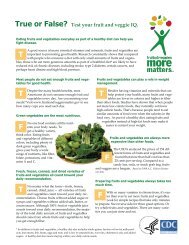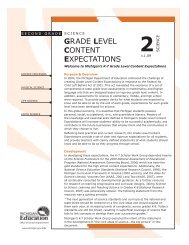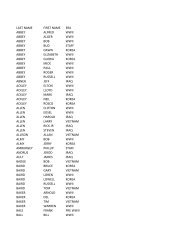Grade Level Content Expectations - State of Michigan
Grade Level Content Expectations - State of Michigan
Grade Level Content Expectations - State of Michigan
Create successful ePaper yourself
Turn your PDF publications into a flip-book with our unique Google optimized e-Paper software.
NUMBER AND<br />
Count, write, and order numbers<br />
OPERATIONS N.ME.00.01 Count objects in sets up to 30.*<br />
N.ME.00.02 Use one-to-one correspondence to compare and order sets <strong>of</strong> objects to<br />
30 using phrases such as “same number”, “more than”, or “less than”; use counting and matching.<br />
N.ME.00.03 Compare and order numbers to 30 using phrases such as “more than” or<br />
“less than.”<br />
N.ME.00.04 Read and write numbers to 30 and connect them to the quantities they represent.*<br />
N.ME.00.05 Count orally to 100 by ones. Count to 30 by 2’s, 5’s and10’s using grouped objects<br />
as needed.<br />
Compose and decompose numbers<br />
N.ME.00.06 Understand the numbers 1 to 30 as having one, or two, or three groups <strong>of</strong> ten and<br />
some ones. Also count by tens with objects in ten-groups to 100.<br />
N.MR.00.07 Compose and decompose numbers from 2 to 10, e.g., 5 = 4 + 1 = 2 + 3, with attention<br />
to the additive structure <strong>of</strong> number systems, e.g., 6 is one more than 5, 7 is one more than 6.*<br />
N.MR.00.08 Describe and make drawings to represent situations/stories involving putting<br />
together and taking apart for totals up to 10; use finger and object counting.<br />
Add and subtract numbers<br />
N.MR.00.09 Record mathematical thinking by writing simple addition and subtraction sentences,<br />
e.g., 7 + 2 = 9, 10 - 8 = 2.<br />
Explore number patterns<br />
N.MR.00.10 Create, describe, and extend simple number patterns.<br />
MEASUREMENT Explore concepts <strong>of</strong> time<br />
M.UN.00.01 Know and use the common words for the parts <strong>of</strong> the day (morning, afternoon,<br />
evening, night) and relative time (yesterday, today, tomorrow, last week, next year).<br />
M.TE.00.02 Identify tools that measure time (clocks measure hours and minutes; calendars<br />
measure days, weeks, and months).<br />
M.UN.00.03 Identify daily landmark times to the nearest hour (lunchtime is 12 o’clock;<br />
bedtime is 8 o’clock).<br />
Explore other measurement attributes<br />
M.UN.00.04 Compare two or more objects by length, weight and capacity, e.g., which is shorter,<br />
longer, taller<br />
M.PS.00.05 Compare length and weight <strong>of</strong> objects by comparing to reference objects, and use<br />
terms such as shorter, longer, taller, lighter, heavier.<br />
GEOMETRY<br />
Create, explore, and describe shapes<br />
G.GS.00.01 Relate familiar three-dimensional objects inside and outside the classroom to their<br />
geometric name, e.g., ball/sphere, box/cube, soup can/cylinder, ice cream cone/cone, refrigerator/prism.<br />
G.GS.00.02 Identify, sort, and classify objects by attribute and identify objects that do not belong<br />
in a particular group.<br />
Explore geometric patterns<br />
G.GS.00.03 Create, describe, and extend simple geometric patterns.<br />
* revised expectations in italics<br />
M I C H I G A N D E P A R T M E N T O F E D U C A T I O N ■ v. 1 2 . 0 5 ■ M A T H E M A T I C S K I N D E R G A RT E N 3






